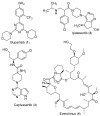Small Molecule Therapeutics in the Pipeline Targeting for Triple-Negative Breast Cancer: Origin, Challenges, Opportunities, and Mechanisms of Action
- PMID: 38892472
- PMCID: PMC11172743
- DOI: 10.3390/ijms25116285
Small Molecule Therapeutics in the Pipeline Targeting for Triple-Negative Breast Cancer: Origin, Challenges, Opportunities, and Mechanisms of Action
Abstract
Triple-negative breast cancer (TNBC) cells are devoid of estrogen receptors (ERs), progesterone receptor (PRs), and human epidermal growth factor receptor 2 (HER2), and it (TNBC) counts for about 10-15% of all breast cancers. TNBC is highly invasive, having a faster growth rate and a higher risk of metastasis and recurrence. Still, chemotherapy is one of the widely used options for treating TNBC. This study reviewed the histological and molecular characterization of TNBC subtypes, signaling pathways that are aberrantly expressed, and small molecules targeting these pathways, as either single agents or in combination with other therapeutic agents like chemotherapeutics, immunotherapeutics, and antibody-drug conjugates; their mechanisms of action, challenges, and future perspectives were also reviewed. A detailed analytical review was carried out using the literature collected from the SciFinder, PubMed, ScienceDirect, Google Scholar, ACS, Springer, and Wiley databases. Several small molecule inhibitors were found to be therapeutics for treating TNBC. The mechanism of action and the different signaling pathways through which the small molecules exert their effects were studied, including clinical trials, if reported. These small molecule inhibitors include buparlisib, everolimus, vandetanib, apatinib, olaparib, salidroside, etc. Some of the signaling pathways involved in TNBC, including the VEGF, PARP, STAT3, MAPK, EGFR, P13K, and SRC pathways, were discussed. Due to the absence of these biomarkers, drug development for treating TNBC is challenging, with chemotherapy being the main therapeutic agent. However, chemotherapy is associated with chemoresistance and a high toxicity to healthy cells as side effects. Hence, there is a continuous demand for small-molecule inhibitors that specifically target several signaling pathways that are abnormally expressed in TNBC. We attempted to include all the recent developments in this field. Any omission is truly unintentional.
Keywords: breast cancer; chemoresistance; chemotherapy; estrogen receptor; human epidermal growth factor receptor 2; immunotherapy; progesterone receptor; signaling pathways; small molecules; triple-negative breast cancer.
Conflict of interest statement
The authors declare no conflicts of interest.
Figures








Similar articles
-
STAT3 as a potential therapeutic target in triple negative breast cancer: a systematic review.J Exp Clin Cancer Res. 2019 May 14;38(1):195. doi: 10.1186/s13046-019-1206-z. J Exp Clin Cancer Res. 2019. PMID: 31088482 Free PMC article.
-
Targeting Different Pathways Using Novel Combination Therapy in Triple Negative Breast Cancer.Curr Cancer Drug Targets. 2020;20(8):586-602. doi: 10.2174/1570163817666200518081955. Curr Cancer Drug Targets. 2020. PMID: 32418525 Review.
-
Molecular targets and therapeutics in chemoresistance of triple-negative breast cancer.Med Oncol. 2021 Nov 23;39(1):14. doi: 10.1007/s12032-021-01610-x. Med Oncol. 2021. PMID: 34812991 Review.
-
Recent Advances in Immunotherapy and Targeted Therapy of Triple Negative Breast Cancer.Curr Pharm Biotechnol. 2025;26(3):365-391. doi: 10.2174/0113892010303244240718075729. Curr Pharm Biotechnol. 2025. PMID: 39092645 Review.
-
Kinase inhibitors for precision therapy of triple-negative breast cancer: Progress, challenges, and new perspectives on targeting this heterogeneous disease.Cancer Lett. 2022 Oct 28;547:215775. doi: 10.1016/j.canlet.2022.215775. Epub 2022 Jun 3. Cancer Lett. 2022. PMID: 35667515 Review.
Cited by
-
Docetaxel Resistance in Breast Cancer: Current Insights and Future Directions.Int J Mol Sci. 2025 Jul 23;26(15):7119. doi: 10.3390/ijms26157119. Int J Mol Sci. 2025. PMID: 40806254 Free PMC article. Review.
-
Dual-Gating Strategy: Ultrasound Activation of TRPV2 Channels and Borate-Glass-Induced Calcium Overload for Tumor Suppression.Adv Sci (Weinh). 2025 Apr;12(16):e2414676. doi: 10.1002/advs.202414676. Epub 2025 Feb 27. Adv Sci (Weinh). 2025. PMID: 40013983 Free PMC article.
-
Synthesis, Anticancer Screening, and In Silico Evaluations of Thieno[2,3-c]pyridine Derivatives as Hsp90 Inhibitors.Pharmaceuticals (Basel). 2025 Jan 24;18(2):153. doi: 10.3390/ph18020153. Pharmaceuticals (Basel). 2025. PMID: 40005967 Free PMC article.
-
CD151 Promotes Cancer Progression in Triple-Negative Breast Cancer by Inducing EMT through the MAPK Signaling Pathway.Breast Cancer (Dove Med Press). 2025 May 28;17:455-470. doi: 10.2147/BCTT.S518760. eCollection 2025. Breast Cancer (Dove Med Press). 2025. PMID: 40458675 Free PMC article.
-
Synthesis and evaluation of quinolinvinyl-phenoxy-1,2,3-triazole-acetamide hybrids against breast cancer.Sci Rep. 2025 May 16;15(1):17058. doi: 10.1038/s41598-025-01051-w. Sci Rep. 2025. PMID: 40379771 Free PMC article.
References
Publication types
MeSH terms
Substances
Grants and funding
LinkOut - more resources
Full Text Sources
Research Materials
Miscellaneous

